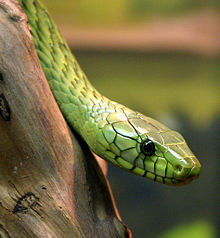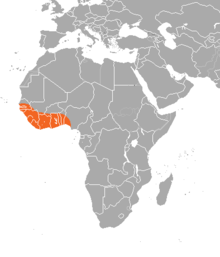- Western green mamba
-
Western green mamba 
Scientific classification Kingdom: Animalia Phylum: Chordata Subphylum: Vertebrata Class: Reptilia Order: Squamata Suborder: Serpentes Family: Elapidae Genus: Dendroaspis Species: D. viridis Binomial name Dendroaspis viridis
(Hallowell, 1844)[1]
Dendroaspis viridis range Synonyms The Western green mamba (Dendroaspis viridis), or also known as the West African green mamba or Hallowell's green mamba, is a long, thin and highly venomous arboreal snake of the family Elapidae.[3]
Contents
Geographic range
The Western green mamba is native to West Africa and occurs in southern Senegal, Gambia, Guinea-Bissau, Guinea, Sierra Leone, Liberia, Côte d’Ivoire, Ghana, Togo, Benin, and southwest Nigeria.[4][5] It can also be found in the very southern tip of Mali along the border with Côte d’Ivoire, western Cameroon and Gabon.[6][5]
Habitat
Western green mamba's live mainly in the coastal tropical rainforest, thicket, and woodland regions of western Africa.[4][7] Although mainly found in dense and closed forests, these snakes can persist in areas where the tree cover has been removed, providing that sufficient hedges and thicket remain. In areas where there is very severe encroachment on their natural habitat or areas where vegetation or trees have been destroyed, these snakes will go into suitably vegetated city suburbs and towns often dwelling in the thickets of bushes or atop lush trees in parks and other well vegetated areas.[7][6]
Description
Smaller than the Black mamba, but larger than the Eastern green mamba the Western green mamba is a long and very slender bodied snake with a long tapering tail. It is the largest of the arboreal mamba's. The average length of an adult snake of this species is between 1.8 metres (5.9 ft) and 2.2 metres (7.2 ft). Most are around 1.8 metres (5.9 ft), but specimens measuring around 2 metres (6.6 ft) are quite common also. Some specimens of this species can grow to lengths of 3.2 metres (10 ft), which is the maximum for this snake.[6][7] The head is narrow and elongate, with a distinct canthus and slightly distinct from the neck. On rare occasions the neck may be flattened when the snake is aroused, but there is no hood. Eyes are medium in size with round pupils and a yellow brown iris.[7] Although the vast majority of specimens are greenish-yellow, olive green, or emerald green in colour, some specimens have shown different colouration. Although very rare, light blue or full yellow specimens do occur. The scales of the body of this species have a black edging. The dorsal scales of this snake are oblique, smooth, narrow, and exceptionally large for an elapid.[6][7][8]
Scalation
Dorsal scales at mid-body 13, ventrals 211-225, subcaudals 107-120, subcaudals are paired, anal plate is divided, upper labials 7-9, pre-oculars 3, post-oculars 3-4, lower labials 8-10, temporals 2+1 variable.[6]
Behavior, Prey, and Predators
This species is mostly diurnal, but may be active at night as well.[8] It is an arboreal snake, but it does commonly go to the ground. In fact, it is equally at home hunting and feeding on prey on the ground or in trees. When it wants to sleep it seeks out tree branches that offer dense cover. It is a very quick, extremely agile, alert, and very aggressive and nervous snake.[7] When confronted it will quickly attempt to escape (usually up a tree if possible) and avoid any sort of confrontation.[7] If cornered, the Western green mamba is highly dangerous and will show a fearsome display of aggression, loudly hissing and striking repeatedly.[6][8][7]
Prey
The Western green mamba's natural prey consists mainly of birds and small mammals, including rodents such as mice, rats, and squirrels. Other mammals include bats, tree pangolins, and shrews.[8][7] They also feed on lizards, frogs, and bird eggs. This snake actively pursues its prey, striking rapidly and often until the prey succumbs to the venom.[9][7]
Predators
The Western green mamba has no natural predators, but humans and birds of prey are this snakes main threat.[3][9]
Venom
The Western green mamba's venom is similar to other members of the Mamba (Dendroaspis) family, but differs from other mamba's in toxicity or even the mixture of toxins in the venom at times. The venom consists mainly of neurotoxins, cardiotoxins,[4][8] and fasciculins.[7] The SC LD50 for this species is 0.7 mg/kg[10] and the average venom yield per bite is approximately 100 mg.[11] Human fatalities as a result of bites from this species are rare due to the fact that this species does not often cross paths with humans, but bites have occurred and many of the recorded bites have been fatal.[4][7] The mortality rate of untreated bites is not exactly known,[7] but is said to be quite high (probably somewhere between 50%-70% as an educated guess according to Ernst and Zug et al. 1996). When bitten, symptoms rapidly begin to manifest, usually within the first 15 minutes or less.[4] Common symptoms of a bite from a Western green mamba include local pain and swelling, although uncommon, local necrosis can be moderate, ataxia, headache, drowsiness, difficulty breathing, vertigo, hypotension (low blood pressure), diarrhea, dizziness, and paralysis.[7][4] Left untreated, new and more severe symptoms begin to manifest. All symptoms worsen and the victim eventually dies due to suffocation resulting from paralysis of the respiratory muscles. Depending on the nature and severity of a bite, death can occur in as fast as an hour but usually it takes 2-4 hours before an untreated victim dies.[4][9]
Taxonomy
Three very close relatives of the Western green mamba (Dendroaspis viridis) are the Eastern green mamba (Dendroaspis angusticeps), the Black mamba (Dendroaspis polylepis), and the Jameson's mamba (Dendroaspis jamesoni) which has two subspecies: Jameson's green mamba (Dendroaspis jamesoni jamesoni) and Jameson's black-tail mamba (Dendroaspis jamesoni kaimosea).[3][7]
Gallery
References
- ^ The Reptile Database. www.reptile-database.org.
- ^ Boulenger, G.A. 1896. Catalogue of the Snakes in the British Museum (Natural History), Volume III. London. p. 435.
- ^ a b c Hallowell, Edward (1844). Description of new species of African reptiles.. 2. Philadelphia, USA: Proceedings of the National Academy of Sciences (Stanford University's Highwire Press). pp. 169-172.
- ^ a b c d e f g Davidson, Terence. "IMMEDIATE FIRST AID". University of California, San Diego. http://drdavidson.ucsd.edu/portals/0/snake/dendroa4.htm. Retrieved 2011-01-11.
- ^ a b O'Shea, Mark (12 September). Venomous Snakes of the World. New Jersey, USA: Princeton University Press. ISBN 0691124361.
- ^ a b c d e f Devenomized - Western Green Mamba
- ^ a b c d e f g h i j k l m n o "Clinical Toxinology Resource (Western Green Mamba)". University of Adelaide. http://www.toxinology.com/fusebox.cfm?fuseaction=main.snakes.display&id=SN0171. Retrieved 2011-01-11.
- ^ a b c d e Zug, George R. (1996). Snakes in Question: The Smithsonian Answer Book. Washington D.C., USA: Smithsonian Institution Scholarly Press. ISBN 1560986484.
- ^ a b c Johnson, Linda (1987). Mamba's. USA: Rourke Enterprises. ISBN 0865929602.
- ^ SC LD50 (Dr. Bryan Grieg Fry)
- ^ Venom Yield
External links
- Bushdrums.com - Green Mamba Video filmed in Gabon
Categories:- Elapidae
- Reptiles of Africa
- Snakes of Africa
Wikimedia Foundation. 2010.





